Results 1 to 25 of 26
-
06-29-2015, 06:33 PM #1
Comparing the design and output of the German twin turbo V8's stock and tuned - BMW M S63TU vs. AMG M157 vs. Audi RS6/RS7 4.0 TFSI V8 vs. Porsche 4.8
In this new era that puts a premium on efficiency and emissions (as well as parts sharing among motors) the major German brands have all gone to turbocharged and direct injected V8's for their sedans. In the past BMW had a high revving V10, Mercedes a supercharged V8, and Audi a twin turbo V10. Today we do not see vastly differing approaches.
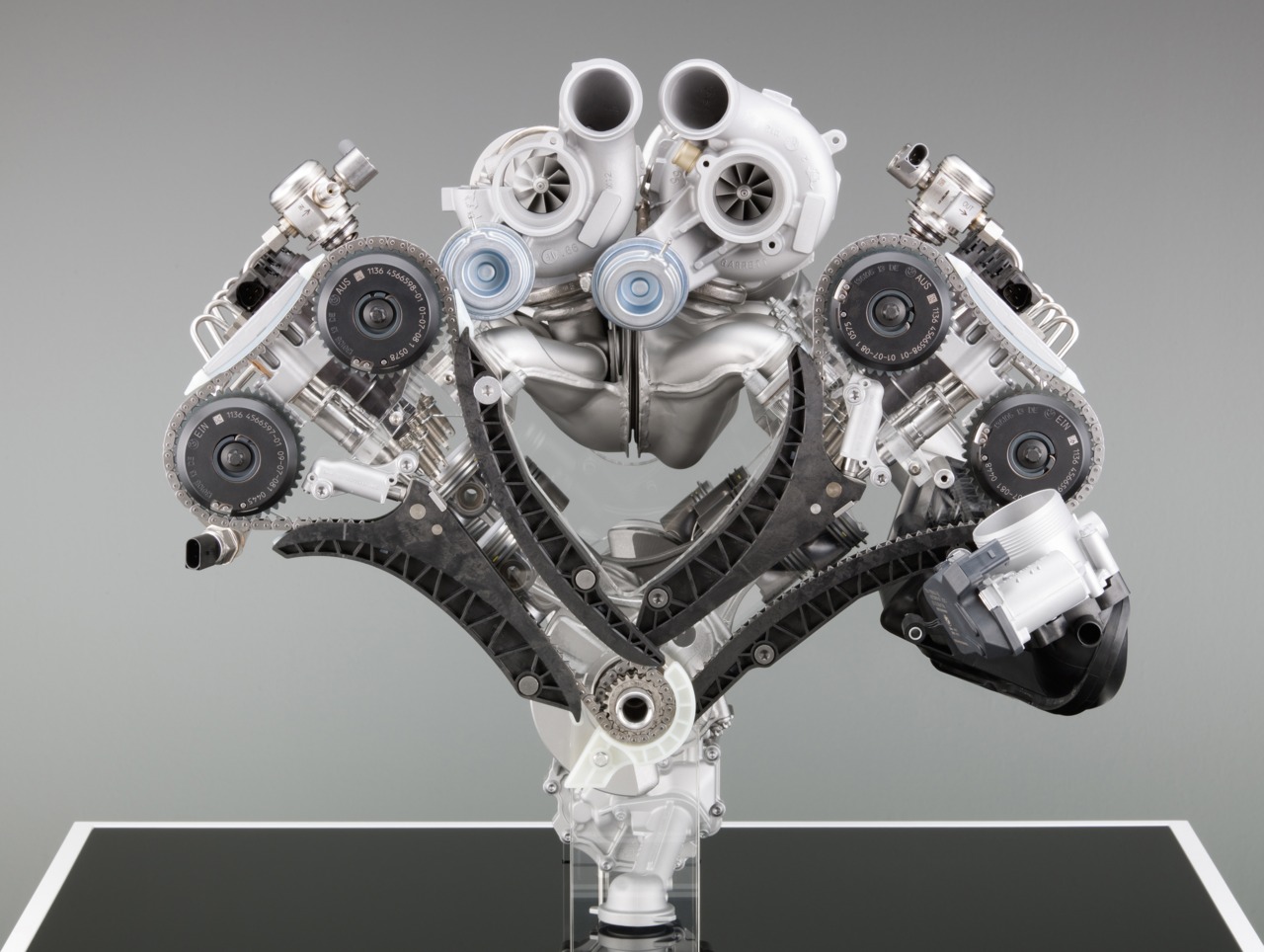
That is not to say the engines are all the same as they are not. There are significant design differences which we will explore in this article. They all are turbocharged however with direct fuel injection and all are V8 designs.
Let's start by taking a look at the 4.4 liter BMW S63TU.

The S63TU is based on the N63 4.4 liter V8 design. The 'S' designates a motor with engineering from the M division. The 'TU' designates a technical update. The N63TU received BMW's Valvetronic variable valve lift system as the did the S63TU which separates them from them from the standard N63 and S63 motors. In the case of the S63TU it also gets a compression bump to 10.0:1 and its peak boost pressure is stated by BMW to be 22 psi.
BimmerBoost previously compared the N63 and S63 designs but will now be looking at the S63TU variant that sees duty in the F10 M5 and F13 M6. What is important to note in the S63 engine design is that it features a pulse tuned, cross engine exhaust manifold.
This design of the manifold is illustrated well here:
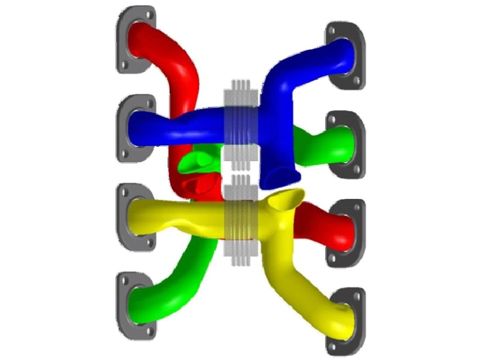
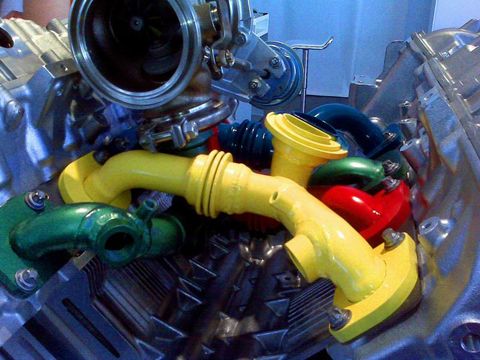
The color coded sections give an idea of how this works. The twin scroll turbochargers receive exhaust pulses from both banks, not just one. This is the main difference between the S63 architecture featuring twin scroll turbos and the N63 architecture using single scroll turbos. The S63 turbos are effectively receiving more exhaust pulses. This is part of the reason the S63TU makes more efficient use of its same 4.4 liter displacement and has greater output.
This brings us to the Mercedes AMG M157.
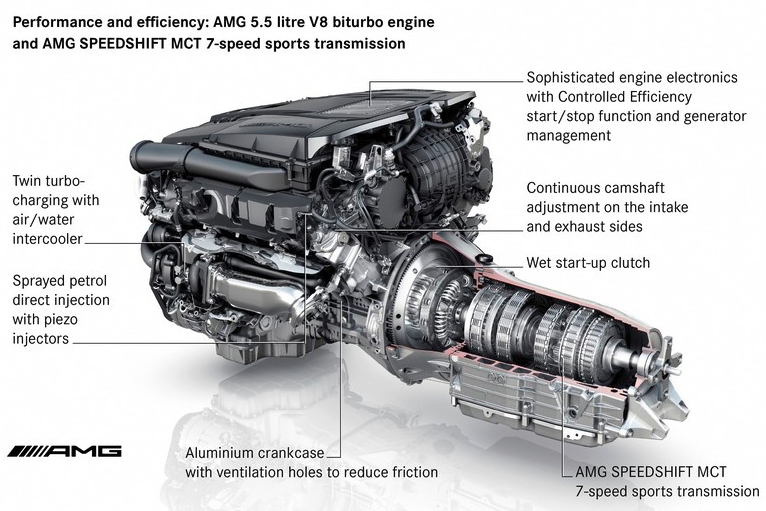
Out of the modern German twin turbo V8 motors AMG offers the largest displacement at 5.5 liters. This is great for low end torque and turbo spool. The AMG design is quite different from BMW.
You will not find the trick exhaust manifolds with the turbos top mounted in the V or valley of the motor. The M157 uses a more traditional layout. It does not feature twin scroll turbos but does feature variable valve timing and direct fuel injection of course. Cooling is courtesy of water to air intercoolers.
The M157 is more of a brute force approach. It's a big V8 with boost so of course it will make power. Speaking with certain tuners they believe the M156 and M159 were better motors than the M157. They had to rev high to make their power though and the M157 with its 6400 rpm redline does not courtesy of the turbo boost.
Mercedes-AMG themselves has adopted a more advanced design for their new 4.0 liter twin turbo M177/M178 V8 with top mounted turbos located in the V of the motor. On the surface it is a very similar design to the Audi 4.0 TFSI V8 which we will now explore.
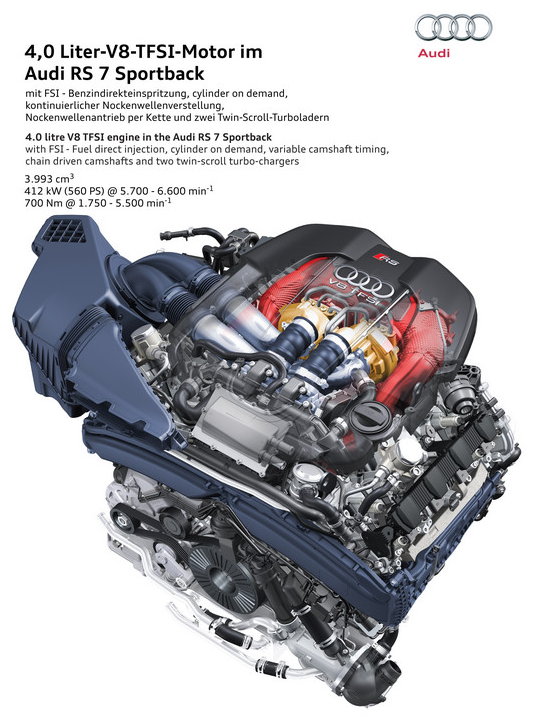
The Audi V8 has the smallest displacement out of the bunch at 4.0 liters. Audi seems to know this and therefore built a very efficient design that responds very well to tuning. You will see that for yourself in the output comparison stock and tuned later on. It is as if Audi designed this motor to be tuned.
The engine has top mounted turbos, twin scroll turbochargers, variable camshaft timing, and direct fuel injection of course. The twin scroll turbochargers are the main difference between the standard S6/S6 4.0 TFSI V8 with single scroll turbochargers and the RS6/RS7 design. The S6, S7, RS6, and RS7 all have the same 10.1:1 compression ratio.
Audi explains the design choices as well as why they did not go the VTG (Variable Turbine Geometry) route well here:
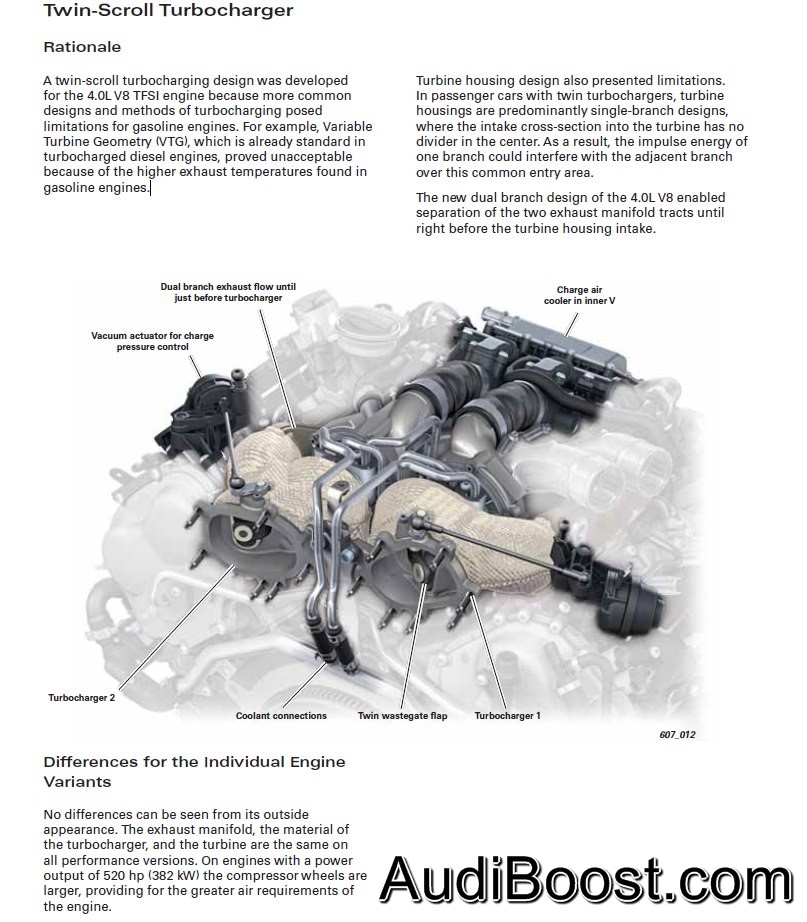
Despite the displacement disadvantage it really isn't giving much of anything up to the big boys offering 560 horsepower in the RS6/RS7 and 516 lb-ft of torque. This is less torque than the 590 lb-ft offered by the 2015 E63 AMG but actually more than the BMW F10 M5 500 lb-ft interestingly enough. At least on paper.
AudiBoost will explore this motor in much further detail in a dedicated article later this week.
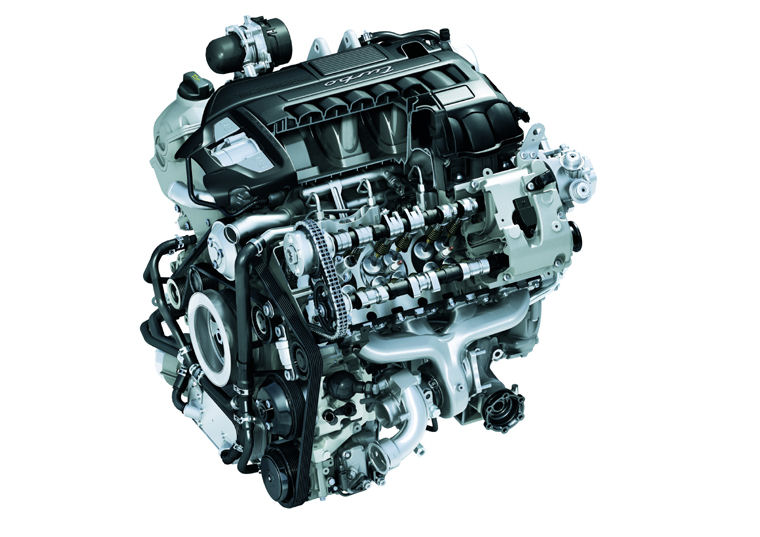
Which brings us to the last motor fittingly as it feels a bit dated. The Porsche 4.8 turbo V8 is not a bad engine by any means. All it really happens to be though is a minor evolution of the original Cayenne Turbo 4.5 liter V8.
Porsche gave it a bit more displacement and direct injection to update it since the V8's introduction in 2003. The Panamera Turbo and Turbo S may be the most expensive but when it comes to performance they lag behind the others. In straightline performance, specifically. Perhaps that is why it has a dry sump oiling system as it is not just a dragster.
The Turbo S is rated at 570 horsepower and 553 lb-ft of torque for the $180k it costs but in practice it has less power and torque than any of these motors when wheel output is considered and namely when tuned. It does have an overboost feature which bumps torque to 590 lb-ft for short bursts which is something similar to a factory tune.
As stated, it is not a bad motor but it just feels a bit dated. The Panamera has a playful chassis but it is a heavy car and even the mighty Turbo S can not keep up with the M5, RS7, or E63 AMG S.
Here is a comparison chart to make it easy to identify the specifications of each motor:
Engine: BMW S63TU AMG M157 Audi 4.0 TFSI Porsche 4.8 Displacement: 4395cc 5461cc 3993cc 4806cc Bore x Stroke: 89x88.3mm 98x90.5mm 84.5x89mm 96x83mm Horsepower: 560/575 577 560 520/570 Torque lb-ft: 500 590 516 516/553 Boost Pressure: 22 psi 14.5 psi 14.5 psi 12.3/13.5 psi Compression: 10.0:1 10.0:1 10.1:1 10.5:1 Redline/Fuel cut: 7100 6400/6600 6600 6500/6700 Valvetrain: DOHC 4V DOHC 4V DOHC 4V DOHC 4V Fuel Injection: Direct Direct Direct Direct
With the factory specs out of the way we can now take a look at what these cars really put down to the wheels. These were all recorded on the Eurocharged all wheel drive Dynojet completely stock. Same fuel, same dyno. It does not get much more uniform than that:

Now, the Mercedes fanboys are probably in an uproar right now due to this graph. Relax gentlemen, this is a E63 M157 dyno of a base care before the facelift and without the Performance Package option. The E63 AMG launched before the RS6/RS7 and the F10 M5 offering its M157 in a 518 horsepower state of tune.
The following graph shows how things have evolved. The M5 is also a Competition Package car and not a standard M5. Turbo motors are allowing manufacturers to play with the output through software alone to top each other (and keep costs down).
This is what an E63 AMG 4Matic looks like today:
This is the E63 AMG S 4MAtic: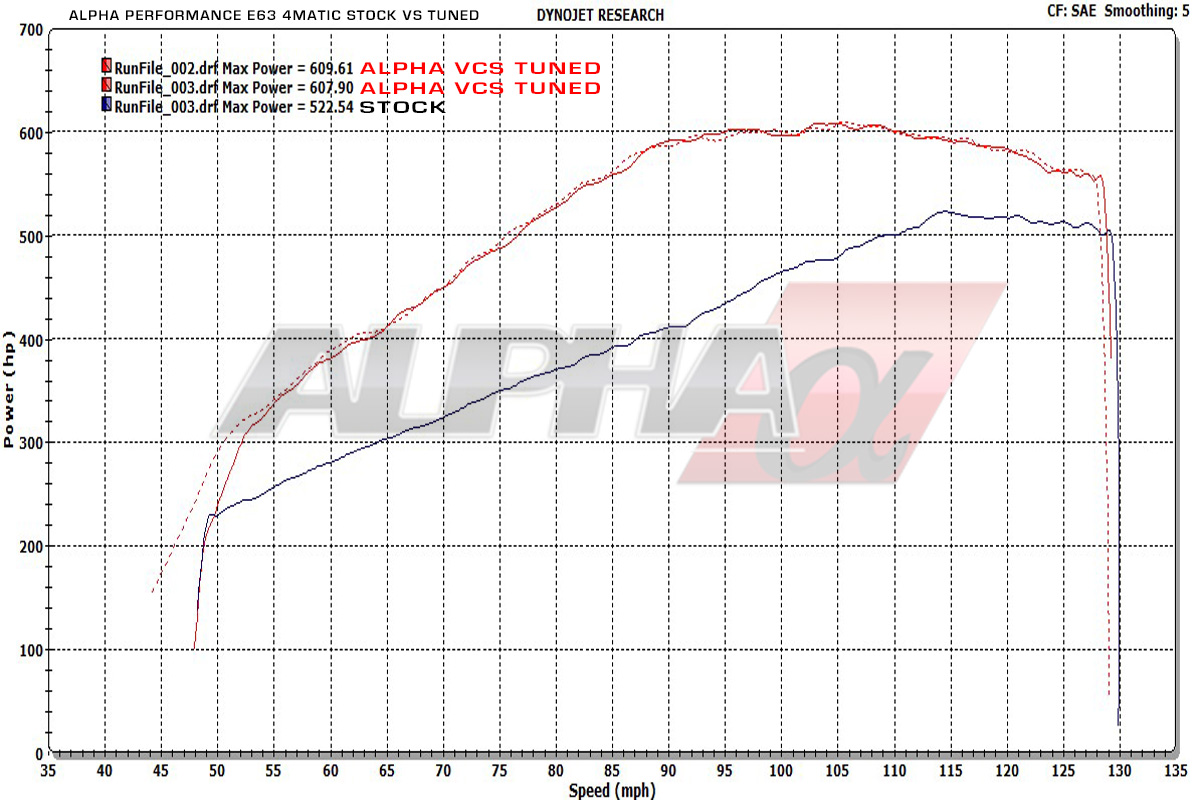
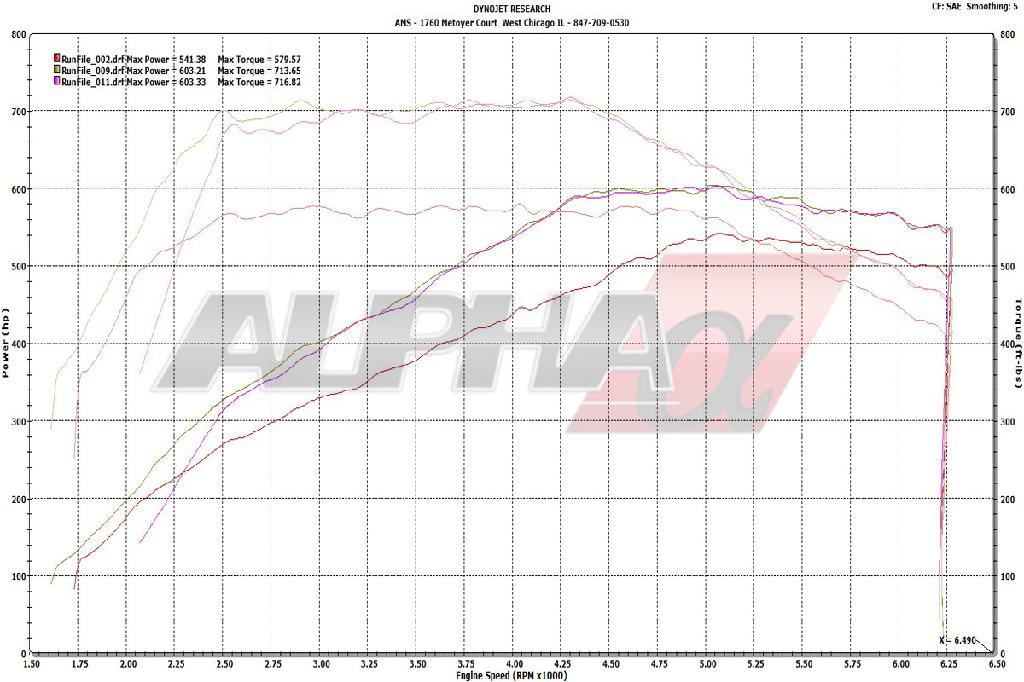
That is quite the spread from the original pre-facelift and pre-4Matic all wheel drive E63 AMG S being sold today, eh? Mercedes now only sells the 4Matic E63 AMG S in the USA. The E63 has grown mostly through just software changes from the original 458 horsepower and 465 lb-ft of torque at the wheels to the 541 horsepower and 579 lb-ft of torque at the wheels you see now. Interesting how AMG responded, eh?
BMW is also playing software games as here is a standard F10 M5:
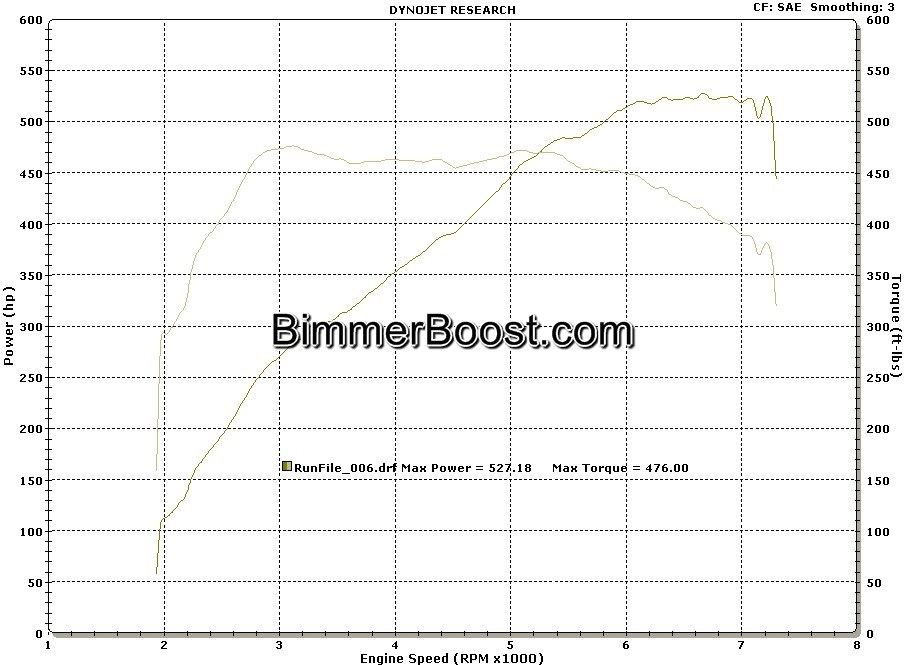
BMW with the Competition Package which gives the S63TU different engine tuning software increases output by 20 wheel horsepower and 28 lb-ft of torque at the wheels.
Each manufacturer is very much aware of what the other is really putting out. This is a horsepower war yet they all are just trying to stay close to one another without taking things too far. They could each increase output further if needed and they each know it.
Look at this aftermarket tune comparison courtesy of Eurocharged:
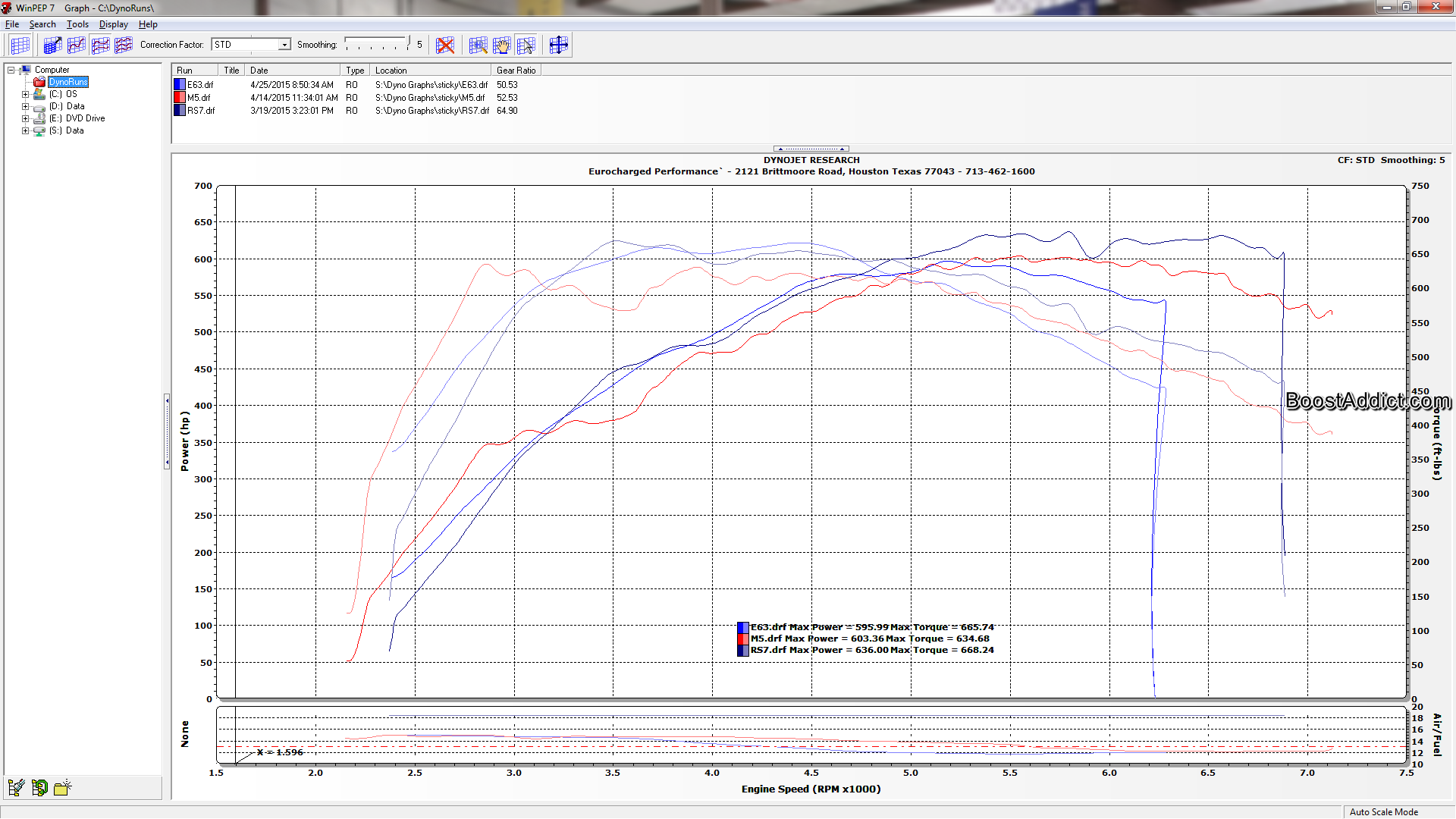
They all end up surprisingly close to each other, don't they? The M5 has the least torque by a paltry ~30 lb-ft at the wheels compared to the others but clearly revs the highest so BMW can make up the displacement disadvantage that way through gearing.
The RS7 is also making nice power up top though and interestingly despite being the smallest motor has the most torque tune only at 668 lb-ft. Do you think Audi did not know what they were doing? They gave the RS6/RS7 4.0 TFSI this kind of room for tune only gains so they would be right there with the E63 and M5 despite the heavy all wheel drive chassis and small 4.0 liter motor. This is all calculated.
The M157 clearly revs the lowest out of the bunch but its displacement is helping it out with good torque down low. The Audi 4.0 TFSI V8 is still matching it yet revving out higher. It also offers more torque and power than the M5 S63TU up top until roughly 6900 rpm thanks to the increased rev limit from Eurocharged. The M5 revs a bit higher than this but it's torque and power are both lower than the 4.0 TFSI V8 before and after this rpm point. The motor that looks the most impressive is actually the smallest, go figure.
You might notice the Panamera Turbo V8 is absent. It is difficult to get Dynojet graphs of the motor and we tried. The best we could do is this Mustang graph of a Panamera Turbo from Switzer before and after their turbo upgrade package:
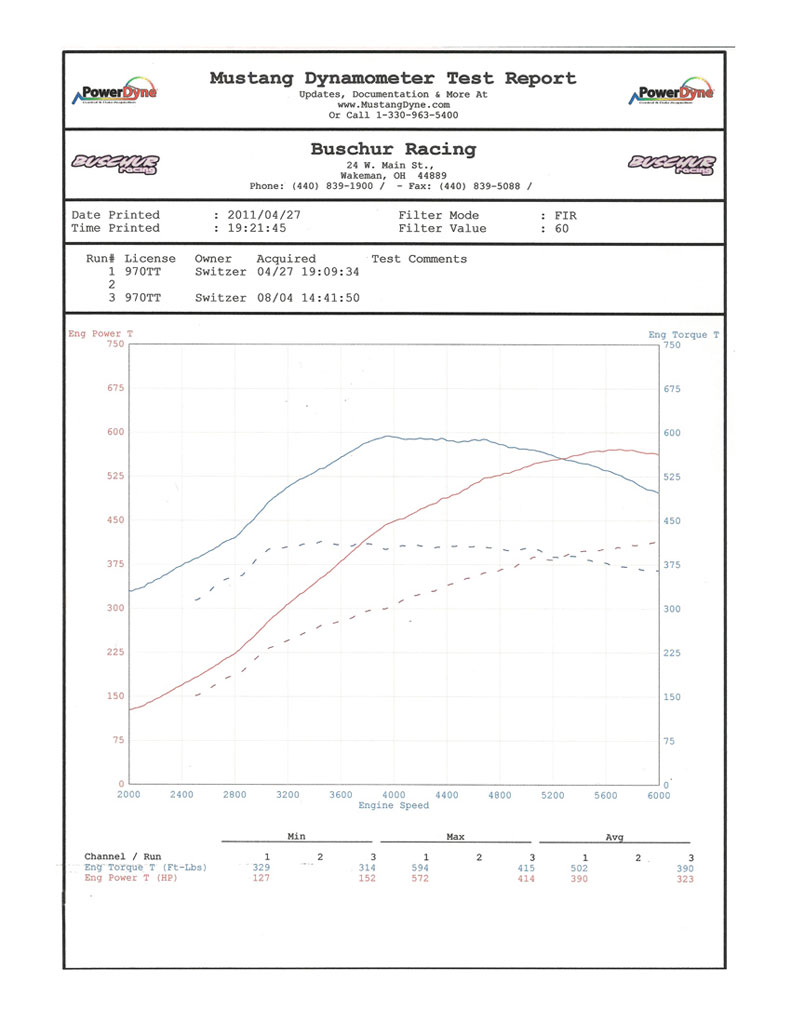
You will notice the Panamera Turbo is offering output closer to the pre-facelift E63 AMG than where the German performance sedans are now. Despite the crank horsepower and torque ratings AMG, M, and Audi are offering far stronger motors. It really takes a turbo upgrade for the Panamera Turbo to match the tuned examples from the others.
There you have it. The twin turbo V8 era brings with it easy tunability and the manufacturers are all aware of this. They are positioning themselves to be close stock and tuned.
If this network was to pick the most impressive motor though it would be the Audi 4.0 TFSI V8 followed by the BMW S63TU. The M157 is just taking more of a brute force than finesse approach and AMG themselves is changing the design now with the M177/M178 introduction. Porsche of course in this mid-size class is outgunned by all of them but this will change with the next generation Panamera.
All turbocharged V8's, all direct injected, and all with basic similarities but different approaches. Is this era boring or exciting? You decide.
-
06-29-2015, 06:57 PM #2
-
06-29-2015, 07:40 PM #3
-
06-29-2015, 07:50 PM #4
@Sticky good article. But doesn't BMW quote absolute pressure not gauge on the S63tu? So it's closer to 8psi stock I think.
07 335XI(A008006) 6AT ~105K miles JB4 G5 ISO VSRF DP's
09 135I(VK80379) 6MT. Race Project car.
1) Install Modified Motiv 600 Kit[HTA3076R w/ tial .82] 2) Moton 4 suspension. 3) Build high flow intake manifold with multi-port fuel and relocate OFH 4) Build full cage possible rear diff upgrade 5) Complete staged twin setup with HTA4205R [w/Tial 1.16] 6) Complete dry sump system 7) Sequential maybe
-
06-29-2015, 07:58 PM #5
-
06-29-2015, 08:01 PM #6
So thats 16-17psig? They under quote it? The reason they quote psia is that is independent to elevation.
Also you see this? I'm hoping it is the new Supra with a BMW I6 in it. http://www.technewstoday.com/24687-b...st-sports-car/07 335XI(A008006) 6AT ~105K miles JB4 G5 ISO VSRF DP's
09 135I(VK80379) 6MT. Race Project car.
1) Install Modified Motiv 600 Kit[HTA3076R w/ tial .82] 2) Moton 4 suspension. 3) Build high flow intake manifold with multi-port fuel and relocate OFH 4) Build full cage possible rear diff upgrade 5) Complete staged twin setup with HTA4205R [w/Tial 1.16] 6) Complete dry sump system 7) Sequential maybe
-
06-29-2015, 08:04 PM #7
-
06-29-2015, 08:11 PM #8
BMW quotes 22pisa which is 22-14.7= 7.3psig at see level or 22-10.1= 11.9psig at 10K feet. That is why when Terry cranks the wgdc to the turbos he can only get 16-17psig at whatever altitude he's at in Cali. From a manufactures standpoint it makes sense to quote Absolute pressure as the car will always run that boost max and it confuses the average consumer as we have used gauge primarily for years.
07 335XI(A008006) 6AT ~105K miles JB4 G5 ISO VSRF DP's
09 135I(VK80379) 6MT. Race Project car.
1) Install Modified Motiv 600 Kit[HTA3076R w/ tial .82] 2) Moton 4 suspension. 3) Build high flow intake manifold with multi-port fuel and relocate OFH 4) Build full cage possible rear diff upgrade 5) Complete staged twin setup with HTA4205R [w/Tial 1.16] 6) Complete dry sump system 7) Sequential maybe
-
06-29-2015, 08:50 PM #9
I have no idea what they might be quoting and I hate getting into the various measurements as it just confuses things.
I think BMW marketing just went with a big figure to try to be impressive. Terry measures the car at 16-17 so I think that is what people should go with.
-
06-29-2015, 09:18 PM #10
 Member
Member












- Join Date
- Sep 2012
- Posts
- 1,162
- Rep Points
- 980.2
- Mentioned
- 14 Post(s)
- Rep Power
- 10
Great Job ! This is the stuff that other forums/websites are lacking and why I spend my time here. Nice detailed breakdown with different graphs for comparison and then same tuner/same dyno graphs to keep things as equal as possible. I agree the Audi motor deserves all the credit it gets they really did an amazing job with it being the smallest motor out of the bunch and its hooked up to a great drivetrain for this type of car. It works beautifully with the quattro all wheel drive and RS specific ZF 8 speed giving short ratios with a wide spread so it can launch hard and keep it on boil with its powerband.
-
06-29-2015, 09:22 PM #11
I don't get why with their content or lack thereof they get more traffic. It's like people don't care about quality.
The 'other' Mercedes website has a Toyota Tacoma on the front page with an article about it driving up a volcano. Seriously.
It's truly impressive. There was some guy here saying the 4.0 couldn't match any of the other motors and flipping out over displacement. Yes, the 4.0 is doing just fine and then some. Heh, some people.
-
06-30-2015, 01:10 AM #12
 Member
Member












- Join Date
- Sep 2012
- Posts
- 1,162
- Rep Points
- 980.2
- Mentioned
- 14 Post(s)
- Rep Power
- 10
LMAO that website is tragic for the most part. But but but dude We got Red Carbon Fiber Start/Stop button group buys

audi really went to town on this power train its deff over engineered so the headroom is huge even the trans and all whee drive system has been taking big power from the guys in Russia. Whether it last or not idk but the fact it has handled it to this point and run blazing times speaks a lot about the engineering that went into this drivetrain hats off to them
-
06-30-2015, 07:02 AM #13
 Member
Member



- Join Date
- May 2012
- Posts
- 97
- Rep Points
- 141.1
- Mentioned
- 1 Post(s)
- Rep Power
- 2
-
06-30-2015, 11:44 AM #14
-
07-01-2015, 12:47 PM #15
 Member
Member

- Join Date
- Sep 2011
- Posts
- 77
- Rep Points
- 36.5
- Mentioned
- 0 Post(s)
- Rep Power
- 0
-
07-02-2015, 12:55 PM #16
Interesting article.
You could do something similar for the sportscars segment where the V8 biturbo becomes more common too. McLaren use it in every car of theirs, now Ferrari too in the California and 488. And then there's the M178 of the AMG GT.
-
07-02-2015, 01:30 PM #17
-
07-03-2015, 01:28 PM #18
 Member
Member





- Join Date
- Oct 2010
- Posts
- 1,574
- Rep Points
- 1,903.2
- Mentioned
- 22 Post(s)
- Rep Power
- 20
-
07-03-2015, 01:44 PM #19
-
07-16-2015, 03:17 AM #20
 Member
Member





- Join Date
- Sep 2013
- Posts
- 25
- Rep Points
- 239.2
- Mentioned
- 0 Post(s)
- Rep Power
- 3
-
07-16-2015, 03:18 AM #21
-
08-02-2015, 03:20 PM #22
 Member
Member



- Join Date
- Mar 2015
- Posts
- 86
- Rep Points
- 115.8
- Mentioned
- 4 Post(s)
- Rep Power
- 2
excellent article. check the max boost again quoted for the RS7. I think its in the 17-18psi range... On a tune on pumpgas it runs closer to 30psi and on racegas probably slightly higher...
I wish they put this motor to the R8!
-
08-02-2015, 07:11 PM #23
-
08-02-2015, 07:12 PM #24
Unfortunately it won't be the 4.0 TFSI: http://www.audiboost.com/content.php...6-2017-Audi-R8
-
10-24-2015, 06:32 PM #25
 Member
Member












- Join Date
- Sep 2012
- Posts
- 1,162
- Rep Points
- 980.2
- Mentioned
- 14 Post(s)
- Rep Power
- 10
@Sticky just randomly came across jerry from eurocharged page on instagram and saw some of these graphs. The RS7 has downpipes so its not an apples to apples comparison. They have another m157 on his page that had downpipes in addition to the tune and put down 646whp and 755wtq also on the same dyno






 Quote
Quote






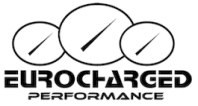





Welcome Haldi,...
Let's point and laugh at Haldi